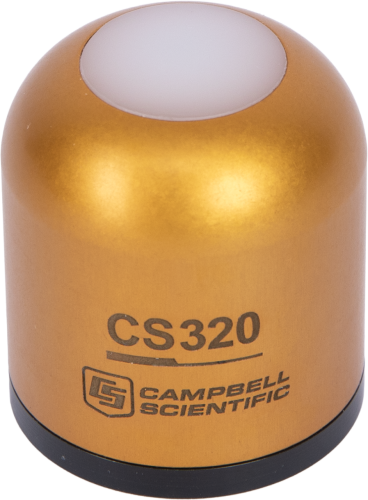
変化する気象条件下での全天日射測定用






概要
利点と特徴
- サーモパイルセンサはシリコンセル日射計に伴うスペクトル誤差を排除
- 他のサーモパイルセンサと比べはるかに低価格
- オンボードセンサがCS320が水平かどうかを自動的に検出するため、設置、診断、リモートトラブルシューティングが可能
- 長期的な安定性と配置を考慮した設計
- ドーム形状のセンサヘッドにより、露や雨の流出を防止
- 露、霜、雨、雪による誤差を低減するヒータ内蔵
- SDI-12デジタル出力
- センサヘッドから取り外し可能な防水コネクタにより、現場でのメンテナンスが容易
- センサに校正データを保存
イメージ





詳細
仕様
| センサ | サーモパイル検出器、アクリル拡散板、ヒーター、信号処理回路がアルミニウムハウジングに取り付けられています |
| 測定の説明 | 広域スペクトルの短波放射を測定 |
| ISO クラス | クラス C (セカンドクラス) |
| 校正の不確かさ | ± 2.6% |
| 測定範囲 | 0 ~ 2000 W/m2 (純短波放射照度) |
| 測定の再現性 | < 1% |
| 長期ドリフト | < 2% (年間) |
| 非直線性 | < 1% |
| 感度 | 0.057 mV/W/m2 |
| 検出器の種類 | Blackbody thermopile |
| SDI-12 応答時間 | 2 s |
| 視野 (FOV) | 180° |
| スペクトル範囲 | 385 ~ 2105 nm (50% ポイント) |
| 方向 (コサイン) 応答 | < ±20 W/m2 (太陽天頂 80° の場合) |
| 温度応答 | < 5% (-15° から +45°C まで) |
| 出力 | SDI-12 (バージョン 1.4) 1200 bps |
| ゼロ オフセット A | 8 W/m2 |
| ゼロ オフセット B | < 5 W/m2 |
| 動作温度範囲 | -50° ~ +60°C |
| 動作環境 | 相対湿度0~100% |
| ヒーター | 0.2 W (オンボード) |
| ヒーター消費電流 | 25 mA (@12 Vdc) |
| 入力電圧要件 | 6 ~ 24 Vdc |
| 電流ドレイン |
|
| 1 日の合計の不確実性 | < 5% |
| 雲による誤差 | ±2 % |
| 機械定格 | IP66/68 |
| 工場校正 | スイスのダボスにある世界放射線基準にトレーサブルな二次標準黒体熱電対日射計にトレーサブル |
| 規格への準拠 |
|
| 保証 | 材料および製造上の欠陥に対する 4 年間の保証 |
| 直径 | 3.43 cm (1.35 in.) |
| 高さ | 3.96 cm (1.56 in.) |
| 重量 |
~65 g (2.3oz) 設置方法により異なる場合があります |
互換性
注意: 以下は代表的な互換性情報を示しています。互換性のある製品や互換性のない製品をすべて網羅したリストではありません。
Data Loggers
| 製品 | 互換性 | 注意 |
|---|---|---|
| CR1000 (リタイア) | ||
| CR1000X (リタイア) | ||
| CR300 (リタイア) | ||
| CR3000 (リタイア) | ||
| CR350 | ||
| CR6 | ||
| CR800 (リタイア) | ||
| CR850 (リタイア) |
互換性に関する追加情報
CS320日射計の測定には、MまたはCコマンドを含むSDI-12機能を備えた測定器が必要です。
設置
正確な測定には、#18356水準器を使ってセンサを水平にする必要があります。この水準器には、バブルレベルと3本の水準器用ネジが組み込まれています。#18356は、CM225取り付けスタンドを使ってクロスアームに取り付けます。CS320は、測定に悪影響を及ぼす可能性のある障害物や反射面から離して取り付ける必要があります。
ダウンロード
CS320 Program Example (3 KB) 11-08-2021
Two example programs that use the M4! command to return solar radiation (W/m^2), raw millivolt value (mV), sensor temperature (°C), and Z-axis values (°). The programs also calculate the daily total flux (MJ). One example program also controls the heater based on air temperature measurements, dewpoint calculations, and battery voltage measurements. The HygroVue™10 Air Temperature and Relative Humidity Probe provides the measurements used in the dewpoint calculation.
よくある質問
CS320に関するよくある質問の数: 9
すべて展開すべて折りたたむ
-
水平調整ベースは物理的な安定性を提供し、センサが適切に水平に保たれるようにします。ベースなしでセンサを使用することはお勧めしません。センサは付属のボルトでベースに取り付けられます。ただし、穴が開けられたユーザー提供のプレートを代わりに使用して、センサの取り付けボルトを取り付けることもできます。
注意: どのような取り付け方法を使用する場合でも、センサが正しく動作するために水平にする必要があります。
-
SDI-12 バスには、それぞれ 200 フィートのケーブルを持つ少なくとも 10 個のセンサを接続できます。センサの数が少ないほど、ケーブル長を長くすることができます。
-
晴れた日で太陽が頭上にあるときに、センサを最近校正した CS320 と比較します。基準として使用しているセンサも水平であることを確認します。
-
精度を最大限に高めるために、Campbell Scientific では通常、すべてのセンサを 2 年ごとに再校正することを推奨しています。アプリケーションの要件によっては、再校正サイクルの間隔を長くすることが望ましい場合があります。日射計の再校正が必要かどうかを判断するには、Clear Sky Calculator の Web ページにアクセスしてください。
詳細については、「太陽放射測定の精度を確認する方法」のブログ記事をお読みください。
-
すべてのセンサに異なるケーブル終端オプションがあるわけではありません。特定のセンサで利用可能なオプションは、センサ製品ページの注文情報エリアの 2 つの場所で確認できます。
モデル番号
ケーブル終端オプション リスト
センサが –ET、–ETM、–LC、–LQ、または –QD バージョンで提供されている場合、そのオプションが利用可能かどうかはセンサモデル番号に反映されます。たとえば、034B は 034B-ET、034B-ETM、034B-LC、034B-LQ、および 034B-QD として提供されています。その他のすべてのケーブル終端オプション (利用可能な場合) は、センサ製品ページの注文情報エリアの「ケーブル終端オプション」の下にリストされています。たとえば、034B-L 風力発電セットは、034B-L 製品ページの注文情報エリアに示されているように、–CWS、–PT、および –PW オプションで提供されています。
注意: 新しい製品が在庫に追加されると、通常は複数のモデル番号を作成するのではなく、1 つのセンサモデルの下に複数のケーブル終端オプションをリストします。たとえば、HC2S3-L には、HC2S3-LC モデルではなく、CS110 に接続するための –C ケーブル終端オプションがあります。
-
可能な限り、希望するケーブル長のセンサを購入してください。一部のセンサではケーブル長がユーザー指定ですが、他のセンサではケーブル長が設定されています。
古いケーブルを新しい長いケーブルに交換できる場合もあります。
通常、次の理由により、追加のケーブルを既存のケーブルに接続することはできません。
- 一部のセンサ ケーブルには、バラ線先端にブリッジ完了抵抗器があります
- 一部のセンサはケーブルの長さに基づいて調整されます
- 絶縁体の色が同じでない場合があります
- 接続の整合性によっては、エラーや誤動作が発生する可能性があります
ケーブルを接合すると、ケーブル内に水が入り込み、ショートや腐食などの潜在的な問題が発生する可能性が高まり、その結果、測定に問題が発生する可能性があります。
潜在的な問題が発生する可能性があるため、まず Campbell Scientific に連絡してください。センサの詳細について相談せずに、センサ ケーブルを接続しないでください。
-
いいえ。センサを光量子センサにするのは範囲ではありません。光電セルで使用される光フィルタの種類によって、PAR 周波数範囲内の特定の波長の光だけが光電セルに当たるようになります。
-
サーモパイル型日射計の場合、サーモパイルが機器内でセンサとして使用され、高温領域と低温領域 (白黒) にわたって温度勾配が測定されます。放射強度は、2 つの感知領域間の温度差に比例します。正確度は、センサに使用される材料の感度、応答時間、およびセンサを覆うドーム (存在する場合) を構成する材料の歪み特性に依存します。
シリコン光電セル型日射計の場合、電流は太陽光の強度に比例して光感応ダイオードによって生成されます。通常、シリコン光電セル型日射計は可視光の全スペクトルに完全には反応せず、曇りの状態や植物の茂みなど、電磁スペクトルの特定の部分を「見る」ことができません。シリコン光電セル型日射計は、これらの条件下では誤差を生じます。ただし、直射日光が当たる状態では、太陽放射測定値を適切に出力するように調整されています。
ケーススタディ
概要 イラク農業省は、太陽光発電と衛星通信を備えた農業気象観測所の全国ネットワークを展開しました。これらの観測所は、農家、政府の計画担当者、研究者にオープンデータを提供し、エビデンスに基づく農業政策、作物管理、季節計画を支援しています。 地域特有の天気や気候の情報をオンラインで利用できるようにすることで、ネットワークは灌漑、作物保護、研究に関するより適切な判断を可能にし、最終的にはイラク全土での農業の回復力向上に貢献します。 このプロジェクトは、キャンベル・サイエンティフィック社の現地パートナーであるアル・ファカール・フォー・エンジニアリング・プロジェクト社、設置と試運転を管理したイラク農業省の技術チーム、そしてネットワークを運用し農家や研究者とデータを共有するエンドユーザーであるイラク農業気象センターと連携して実施されました。 課題 イラクの農業はいくつかの制約に直面しています。 地方では電力と接続性が不安定で、継続的なデータ収集が困難です。 農家は、灌漑や作物保護を実際の畑の状況に合わせて調整するための、タイムリーで地域的な気象情報を欠いていることがよくあります。 政策立案者や研究者は、季節変動を追跡し、研究試験を検証し、農業普及プログラムを導くために、正確な比較データを必要としています。 信頼できる測定がなければ、決定は推測に基づいて行われることが多くなり、効率が低下し、気候変動に対する脆弱性が高まります。 解決策 Campbell Scientific は、以下のセンサーを搭載した農業気象監視ステーションを供給しました。 蒸発散量(ET)と熱集合を含む気温と湿度 風速と風向 日射 降雨 土壌温度 気圧 各ステーションは太陽光発電で稼働し、衛星テレメトリ(TX ユニット、GNSS アンテナ、充電レギュレータ、バッテリー)が装備されているため、遠隔地や電力網が不安定な場所でも継続的な運用が保証されます。 このネットワークは継続的に気象と土壌の状態を測定し、そのデータを農作物に関する勧告に変換し、www.agromet.gov.iqを通じて農家にその勧告を配信します。 オープンデータ、実践的な影響 オープンデータは、灌漑スケジュールを実際の降雨量やETパターンに合わせたり、風速が低く湿度が適切な時間帯に散布時期を選定したり、影響を受けやすい作物の生育期における高温や低温の状況をモニタリングしたりすることで、農業に実用的なインパクトをもたらすために活用できます。また、データは現地のエビデンスに基づいて圃場試験や普及指導を検証するのにも役立ち、推奨事項が正確かつ実行可能なものとなります。 ネットワークがすでに変化をもたらしている場所 この農業気象学ネットワークがすでに効果を上げている例をいくつか紹介します。 アル・ミシュカブ稲研究ステーションは、水を効率的に利用した稲作と種子の増殖を支援しています。 保護地域であるアル・マダーン苗圃と森林では、林業と砂漠化防止のための微気候の監視が可能です。 アル・シャトラ実証農場は、農業普及および研修プログラムのためのリアルタイムの観察を提供します。 次のステップ このネットワークの計画には、農業研究機関と協力して気候速報をエクスポートすることでネットワークの範囲を拡大することが含まれ、これによりイラク全土の農業コミュニティへの農業気象データの応用がさらに強化されることになる。...続きを読む
南アフリカ南西部では、2015年から2017年まで3年連続で乾燥した冬が続き、2018年初頭にはケープタウンで「デイゼロ」干ばつが発生しました。ケープタウンの水危機は、シャツを洗う回数を誰が一番少なくできるかを競うコンテストが行われるほどに悪化しました。レストランや企業でさえ、客や従業員に排水を減らすよう呼びかけました。この時点で、同市は水道を止めるまであと90日というところでした。 1年後、南アフリカのこの都市の干上がったダムは80%以上が満水になりました。水使用制限は緩和され、ケープタウンの市営水道が停止される「デイ・ゼロ」は到来しませんでした。この危機の回避に関する詳細は、この世界経済フォーラムの記事で確認できます。 乾燥した冬に必要となったケープタウン市は、霧の採取によってこの地域の主な水源を補う可能性を測るプロジェクトをテーブルマウンテンで立ち上げました。まだ初期段階ではありますが、このプログラムの考案者は、山に複数の霧捕集装置を建設することの実現可能性を判断したいと考えています。実現可能性調査と研究段階は、2022年12月までに完了する予定です。 このケース スタディの公開日現在、テーブル マウンテンには、基本的な気象パラメータと収集された霧を測定するための 2 つの Campbell Scientific 気象ステーションが設置されています。両方の気象ステーションには、霧から水を捕らえる、つまり「収穫」するために特別に設計された 1.5 m² (16.2 ft²) のスクリーンが装備されています。 ケープタウン市は、スクリーンに使用できるさまざまな素材のオプションをテストしています。1 つのスクリーンは 40%......続きを読む
記事とプレスリリース
ブログ記事
-
But It’s a Dry Heat… like a Furnace

21-06-2021 著者: Dirk Baker -
Measuring the Sun More Accurately and Simply

13-09-2017 著者: Chod Stephens
Privacy Policy Update
We've updated our privacy policy. 詳細はこちら
Cookie Consent
Update your cookie preferences. クッキーの設定を更新する




